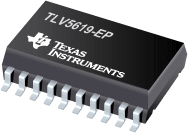

TLV5619-EP是TI公司的一款精密DAC(=<10MSPS)产品,TLV5619-EP是增强型产品 12 位,单通道 Dac,并行,电压输出,低功耗,本页介绍了TLV5619-EP的产品说明、应用、特性等,并给出了与TLV5619-EP相关的TI元器件型号供参考。
TLV5619-EP - 增强型产品 12 位,单通道 Dac,并行,电压输出,低功耗 - 精密DAC(=<10MSPS) - 数模转换器 - TI公司(Texas Instruments,德州仪器)
The TLV5619 is a 12-bit voltage output DAC with a microprocessor and TMS320 compatible parallel interface. The 12 data bits are double buffered so that the output can be updated asynchronously using the LDAC\ pin. During normal operation, the device dissipates 8 mW at a 5-V supply and 4.3 mW at a 3-V supply. The power consumption can be lowered to 50 nW by setting the DAC to power-down mode.
The output voltage is buffered by a ×2 gain rail-to-rail amplifier, which features a Class A output stage to improve stability and reduce settling time.
- Controlled Baseline
- One Assembly/Test Site, One Fabrication Site
- Extended Temperature Performance of –40°C to 125°C
- Enhanced Diminishing Manufacturing Sources (DMS) Support
- Enhanced Product Change Notification
- Qualification Pedigree
- Single Supply 2.7-V to 5.5-V Operation
- ±0.4 LSB Differential Nonlinearity (DNL), ±1.5 LSB Integral Nonlinearity (INL)
- 12-Bit Parallel Interface
- Compatible With TMS320 DSP
- Internal Power On Reset
- Settling Time 1 µs Typ
- Low Power Consumption:
- 8 mW for 5-V Supply
- 4.3 mW for 3-V Supply
- Reference Input Buffers
- Voltage Output
- Monotonic Over Temperature
- Asynchronous Update
- applications
- Battery Powered Test Instruments
- Digital Offset and Gain Adjustment
- Battery Operated/Remote Industrial Controls
- Machine and Motion Control Devices
- Cordless and Wireless Telephones
- Speech Synthesis
- Communication Modulators
- Arbitrary Waveform Generation
Component qualification in accordance with JEDEC and industry standards to ensure reliable operation over an extended temperature range. This includes, but is not limited to, Highly Accelerated Stress Test (HAST) or biased 85/85, temperature cycle, autoclave or unbiased HAST, electromigration, bond intermetallic life, and mold compound life. Such qualification testing should not be viewed as justifying use of this component beyond specified performance and environmental limits.








